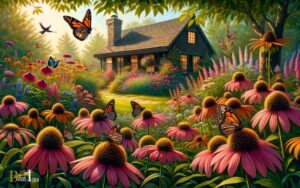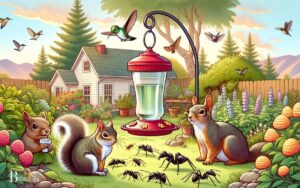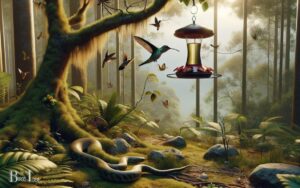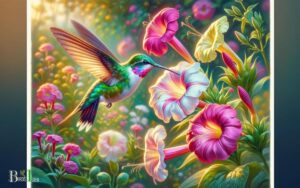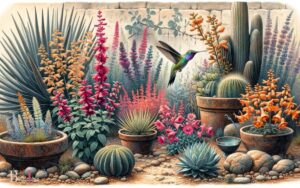How Do You Attract Hummingbirds: Discover!
To attract hummingbirds, create a hospitable environment with nectar-rich flowers, feeders filled with sugar water (1 part sugar to 4 parts water), native flowering plants, and a water source for bathing.
Avoid pesticides, ensure year-round food availability, and opt for red or bright-colored feeders and flowers, which are especially attractive to these birds.
Hummingbirds are attracted to areas that provide their basic needs: food, water, and shelter.
Here’s how you can create an appealing environment for these tiny birds:
By following these guidelines, you can create an inviting habitat for hummingbirds, bringing color and activity to your garden.
Entice the aerial acrobatics of hummingbirds into your garden by offering them a diverse buffet of bright blooms and sweet nectar, ensuring
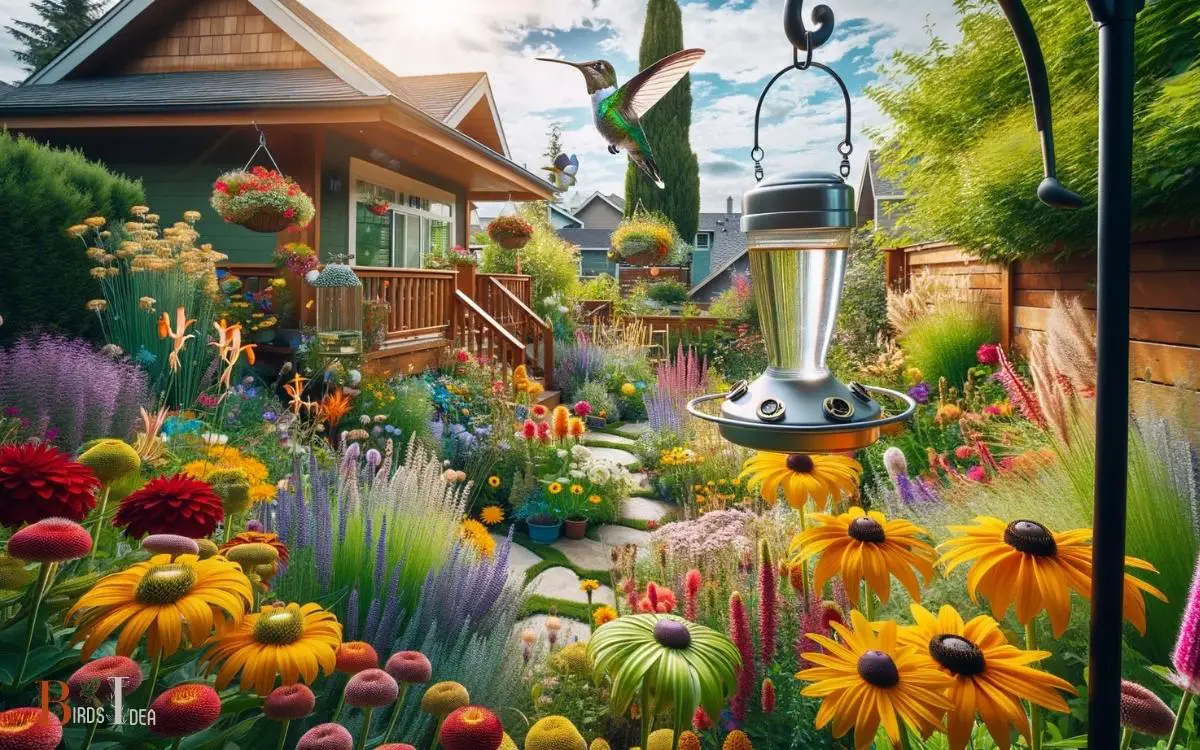
Key Takeaway
Choosing the Right Plants
Hummingbirds are attracted to plants with tubular flowers that are rich in nectar, such as trumpet vine and bee balm. These flowers provide the necessary fuel for their high metabolism.
When choosing plants to attract hummingbirds, it’s essential to opt for a variety of blooms that will provide nectar throughout the entire hummingbird season.
Some good choices include columbine, cardinal flower, and salvia. It’s also important to select plants with different blooming periods to ensure a consistent nectar supply.
Additionally, incorporating native plants into the garden is beneficial, as they have co-evolved with local hummingbird species and are well-suited to their needs.
By carefully choosing the right plants, individuals can create an inviting habitat that will attract and nourish these delightful, tiny birds.
Setting Up Hummingbird Feeders
To supplement the nectar from flowers, homeowners can set up hummingbird feeders to ensure a consistent food supply throughout the hummingbird season.
- Choose a feeder with bright red parts to attract hummingbirds.
- Place the feeder in a shaded area to prevent the nectar from spoiling quickly.
- Keep the feeder clean and filled with fresh nectar to maintain the health of visiting hummingbirds.
- Hang multiple feeders to accommodate territorial hummingbirds and prevent overcrowding at a single feeder.
- Monitor the feeder regularly to ensure it is not attracting unwanted pests like ants or bees.
Providing Water Sources
Homeowners should regularly provide water sources to attract hummingbirds, ensuring these tiny birds have access to both nectar and hydration.
Hummingbirds not only need nectar from flowers and feeders but also require water for drinking and bathing.
To attract them, homeowners can set up a shallow bird bath or a dripping water feature. The water source should be shallow, as hummingbirds are small and prefer shallow water where they can easily bathe and drink.
Adding a few small pebbles to the water source can provide landing spots for the birds and prevent water from splashing out. It’s important to keep the water fresh and clean, changing it regularly to prevent the growth of algae and bacteria.
By providing a consistent water source, homeowners can create an inviting environment for hummingbirds to visit and thrive.
Creating a Safe Environment
Creating a safe environment for hummingbirds involves minimizing potential hazards such as window collisions and predators.
To ensure the safety of these delicate creatures, individuals can take several simple but effective measures:
- Window decals: These can help birds recognize glass and avoid collisions.
- Predator deterrents: Installing motion-activated sprinklers or keeping pets indoors can help deter predators.
- Pruning vegetation: Trimming trees and shrubs near feeders and nectar sources can eliminate hiding spots for predators.
- Regular cleaning: Keeping feeders and bird baths clean helps prevent the spread of diseases that can harm hummingbirds.
- Safe perches: Placing feeders near perches or shrubs allows hummingbirds to retreat quickly if they feel threatened.
Maintenance and Care
Minimizing hazards and ensuring the safety of hummingbirds requires regular maintenance and care.
To maintain a safe environment for these delicate creatures, it’s essential to clean and refill feeders every 3-5 days, especially in warmer weather to prevent mold and bacteria growth.
Regular cleaning also prevents build-up of dirt and debris, ensuring that the feeders and perches remain safe for hummingbirds.
Additionally, it’s important to monitor for any signs of wear and tear on feeders, replacing them when necessary to prevent potential harm to the birds.
Landscaping around the feeding area should also be kept tidy, minimizing the risk of predators and creating a clear flight path for the hummingbirds.
By consistently maintaining and caring for the feeding area, one can ensure a safe and inviting environment for these beautiful birds.
What are Hummingbirds Attracted to?
Hummingbirds are primarily attracted to flowers that produce nectar, which is their main source of food.
They are especially drawn to brightly colored flowers, particularly those that are red, orange, or pink. These colors appear more vibrant to hummingbirds, as they have excellent color vision.
In addition to color, hummingbirds are attracted to flowers with tubular shapes, as their long bills are well-suited for extracting nectar from such blossoms.
Fragrance is generally not a significant factor in attracting hummingbirds, as they rely more on sight than smell.
If you want to attract hummingbirds to your garden, consider planting a variety of nectar-rich flowers, such as trumpet vine, bee balm, salvia, fuchsia, and petunias.
Providing a consistent and reliable source of nectar will encourage hummingbirds to visit your garden regularly.
Additionally, you can set up hummingbird feeders filled with a mixture of four parts water to one part white granulated sugar. Keep the feeders clean and the nectar fresh to ensure the well-being of the hummingbirds.
Why Can’t I Attract Hummingbirds?
If you’re having trouble attracting hummingbirds to your garden, there could be several reasons.
Here are some potential factors to consider:
Lack of Suitable Plants
Hummingbirds are attracted to specific types of flowers that produce nectar, especially those with tubular shapes and bright colors.
Make sure you have a variety of flowers that hummingbirds prefer, such as trumpet vine, bee balm, salvia, fuchsia, and petunias.
Seasonal Considerations
Hummingbirds migrate, and their presence can be seasonal. Ensure that you have blooming flowers during the times when hummingbirds are typically in your region.
Inadequate Feeder Placement
If you’re using hummingbird feeders, their placement is crucial. Hang them in a location where hummingbirds can easily spot them, preferably near the flowers they like. Also, make sure the feeders are clean and filled with fresh nectar.
Cleanliness of Feeders
Hummingbirds can be sensitive to the cleanliness of feeders. Regularly clean your hummingbird feeders to prevent the growth of mold and bacteria. Use a solution of one part white vinegar to four parts water for cleaning.
Nectar Mixture
Ensure that you are using the correct nectar mixture in your feeders. The recommended ratio is four parts water to one part white granulated sugar. Avoid using honey, as it can promote the growth of harmful fungi.
Presence of Pesticides
Pesticides can be harmful to hummingbirds. Avoid using pesticides in your garden, as they may deter these birds.
Patience
It may take some time for hummingbirds to discover your garden or feeder. Be patient, and continue providing a consistent and attractive environment.
Local Habitat
Consider the overall habitat in your area. If there are natural food sources and suitable nesting locations nearby, it may be easier to attract hummingbirds.
By addressing these factors and creating a welcoming environment with the right plants and clean, well-placed feeders, you can increase the likelihood of attracting hummingbirds to your garden.
Conclusion
Attracting hummingbirds to your garden can be a delightful challenge. By selecting the right plants, setting up feeders, providing water sources, and creating a safe environment, you can create a welcoming space for these beautiful creatures.
With some ongoing maintenance and care, you’ll be able to enjoy the company of hummingbirds in your backyard in no time. Happy gardening!


